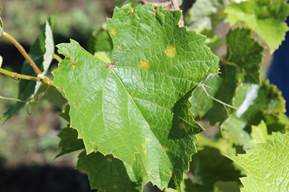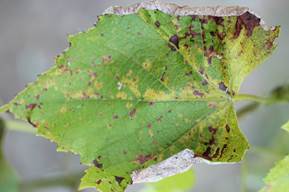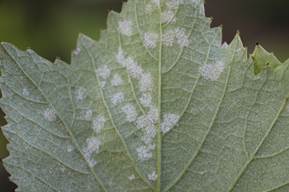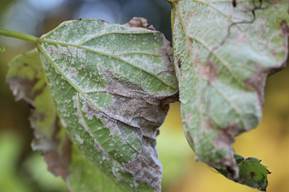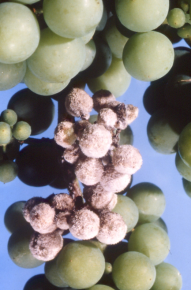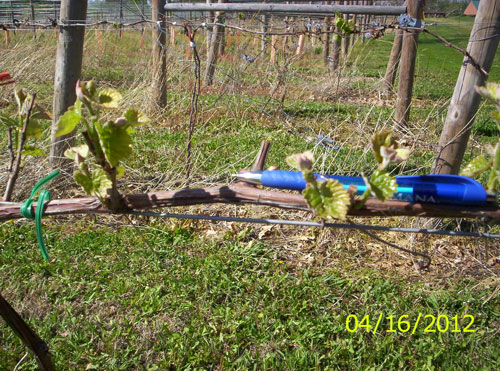Downy Mildew in Grapes — Secrets of Disease Management
Experienced grape growers saw it coming. New growers hadn’t a clue. Regardless, my crystal ball told me that with months of rain would come severe outbreaks of downy mildew in vineyards.
Grape downy mildew has reached epidemic levels in some vineyards in Kentucky and other parts of the Midwest. The pathogen that causes the disease (Plasmopara viticola) is a water mold, which warrants special considerations for disease management. Let’s begin with a quick overview of water molds (oomycetes, to be exact).
Water Molds
Water molds are different from true fungi. In fact, they are not related. Most importantly, water molds require free water to complete their life cycles. Initial infections often occur during rainy spring weather as temperatures begin to warm. After infection, pathogens release large numbers of ‘swimming” spores (zoospores) that move in films of water (damp leaves or moist soil). This is the repeating stage of disease that leads to epidemics if wet conditions persist. Spores are spread by splashing water and wind-driven rain. In addition to downy mildew pathogens, many root rotting pathogens (Phytophthora and Pythium) are water molds.
Figure 1
Downy Mildew
Downy mildew symptoms are quite distinct. Upper leaves are the first to develop noticeable symptoms. Yellow circular to blotchy spots can quickly enlarge and become bright yellow (Fig 1). As disease progresses, leaf tissue becomes reddish-brown, and centers of spots becomes necrotic (dead tissue) (Fig 2). Extreme disease conditions result in a coalescing of spots into large necrotic areas.
Figure 2
The most characteristic symptom of downy mildew is the ‘downy” fungal masses that develop on undersides of leaves (Fig 3). If weather remains rainy or humid/foggy, pathogens will begin producing spore capsules (sporangia) on microscopic branched structures (sporangiophores). This branching gives the disease its fluffy, downy appearance. Sporangia can spread to healthy plant parts by wind or rain, and then open to expose infective, swimming zoospores. This repeating cycle is dependent upon temperature and availability of free water.
Figure 3
Downy mildew pathogens also produce another spore type, thick-walled overwintering spores (oospores), at the end of the season. These spores drop to the ground and overwinter in leaf debris or in soils. In spring, they germinate just as grapes begin to bloom. Thus, early fungicide protection is critical in order to combat the initial phase of disease. Moreover, an effective disease management program (described below) will help eliminate some of the inoculum (oospores) that before they overwinter.
Damage Caused by Downy Mildew
Effects of infection are two-fold. First, diseased leaves fail to properly photosynthesize, while severely infected leaves drop, leading to inadequate energy production (Fig 4). Secondly, grape berries may become infected, leading to yield and quality losses (Fig 5).
Figure 4
Fruit are susceptible to infection from bloom until 3 or 4 weeks after bloom. After that, they become resistant to infection. Berries may not develop symptoms until several weeks after infection. Affected fruit become soft and brown and do not mature. Like foliar infections, infected berries become covered with downy fungal growth when conditions are wet or humid. While fruit become resistant to infection as they mature, cluster stems (rachis) do not. Thus, infections in these cluster stems can spread internally to berries. Additionally, young shoots, leaves, and tendrils remain susceptible to infections throughout the growing season.
Figure 5
Disease Management
Growers must combine cultural and chemical practices to effectively manage downy mildew in grape vineyards.
Cultural practices are important for both conventional and organic growers. Maintaining dry foliage is important. Plant spacing, pruning, tucking, and other practices that improve air circulation will help foliage dry faster, and thus, conditions become less conducive for disease development.
Surface and internal vineyard drainage can also help reduce moisture levels within canopies. Next, sanitation should not be overlooked. To the extent possible, remove diseased leaves, fruit, and other plant parts from vineyards. This will help to prevent fallen debris from becoming a home for overwintering pathogens. Some species and cultivars have some resistance to downy mildew. See page 36 of the Midwest Small Fruit and Grape Spray Guide ID-94 for a partial listing of tolerant grapes.
Fungicides are a vital part of management of downy mildew. Protectant sprays should begin at bud break and continue throughout the growing season. Keep in mind though, that fungicide applications between bud break and 3 to 4 weeks after bloom are the most critical. When selecting fungicides, remember that the downy mildew pathogen is a water mold, not a true fungus. Therefore, not all fungicides will be effective against infection. Refer to Effectiveness of Grape Fungicides PPFS-FR-S-18 or the Midwest Small Fruit and Grape Spray Guide ID-94 for up to date fungicide information.
Additional information on grape production and disease management can be found online at the UK Department of Plant Pathology’s website. http://www2.ca.uky.edu/agcollege/plantpathology/extension/pubs.html#Smallfruit
 Dr. Nicole Ward Gauthier is an Extension Plant Pathologist at the University of Kentucky.
Dr. Nicole Ward Gauthier is an Extension Plant Pathologist at the University of Kentucky.

